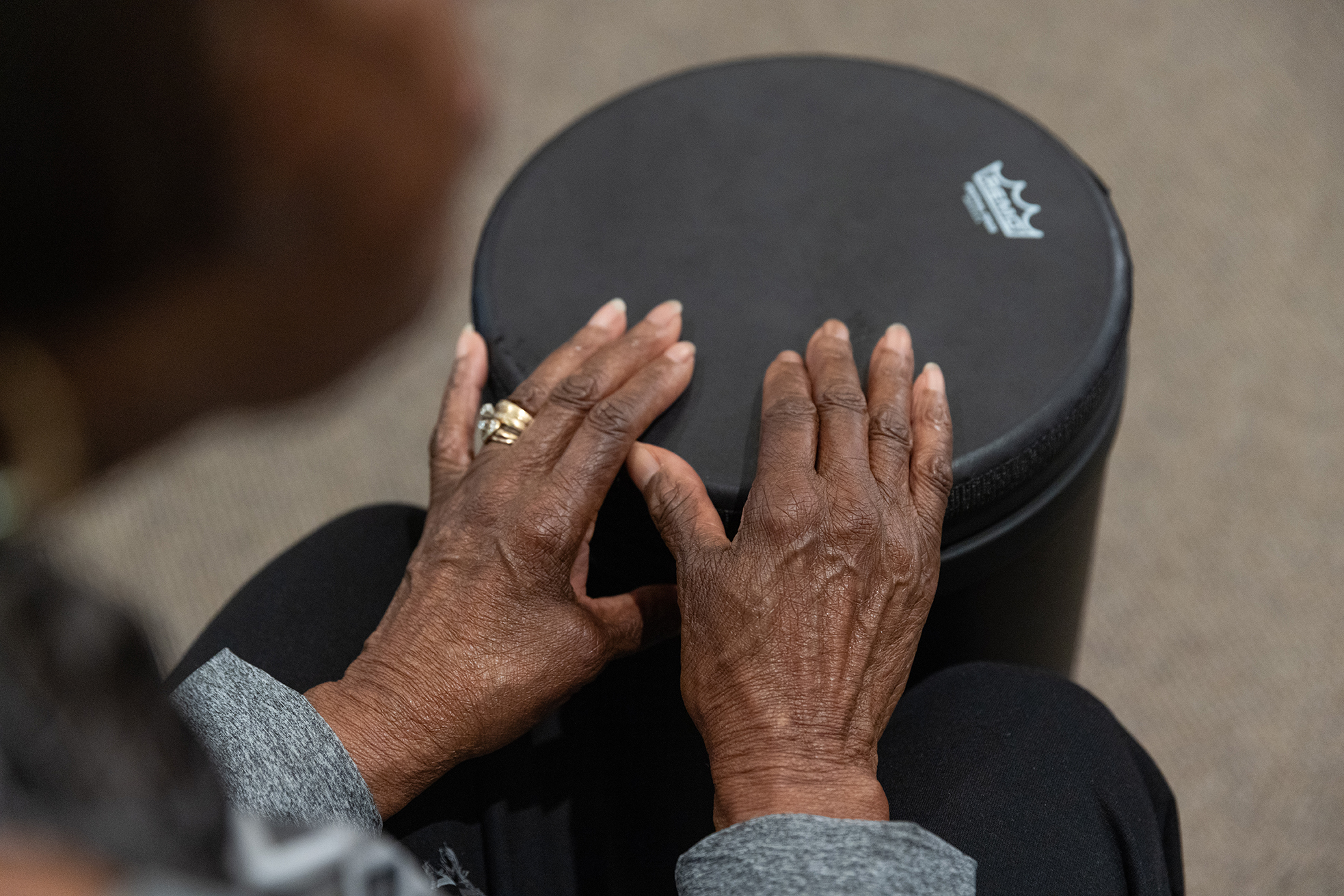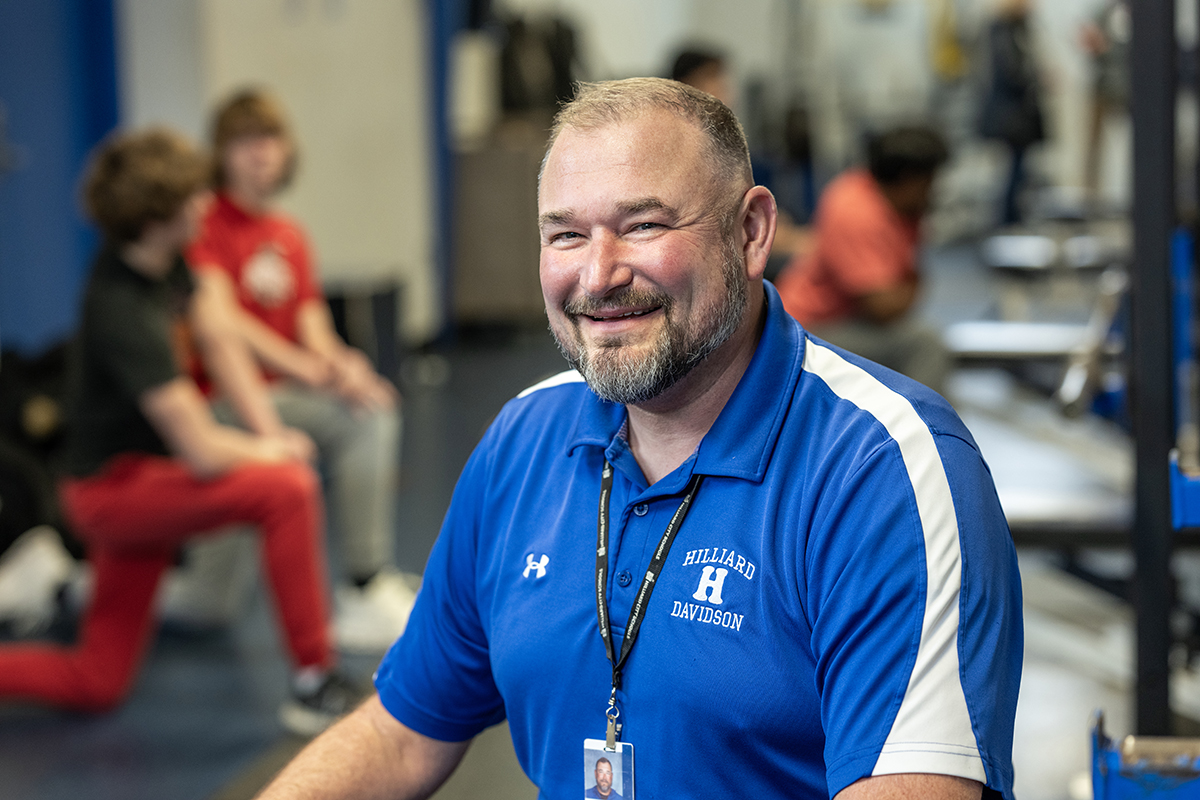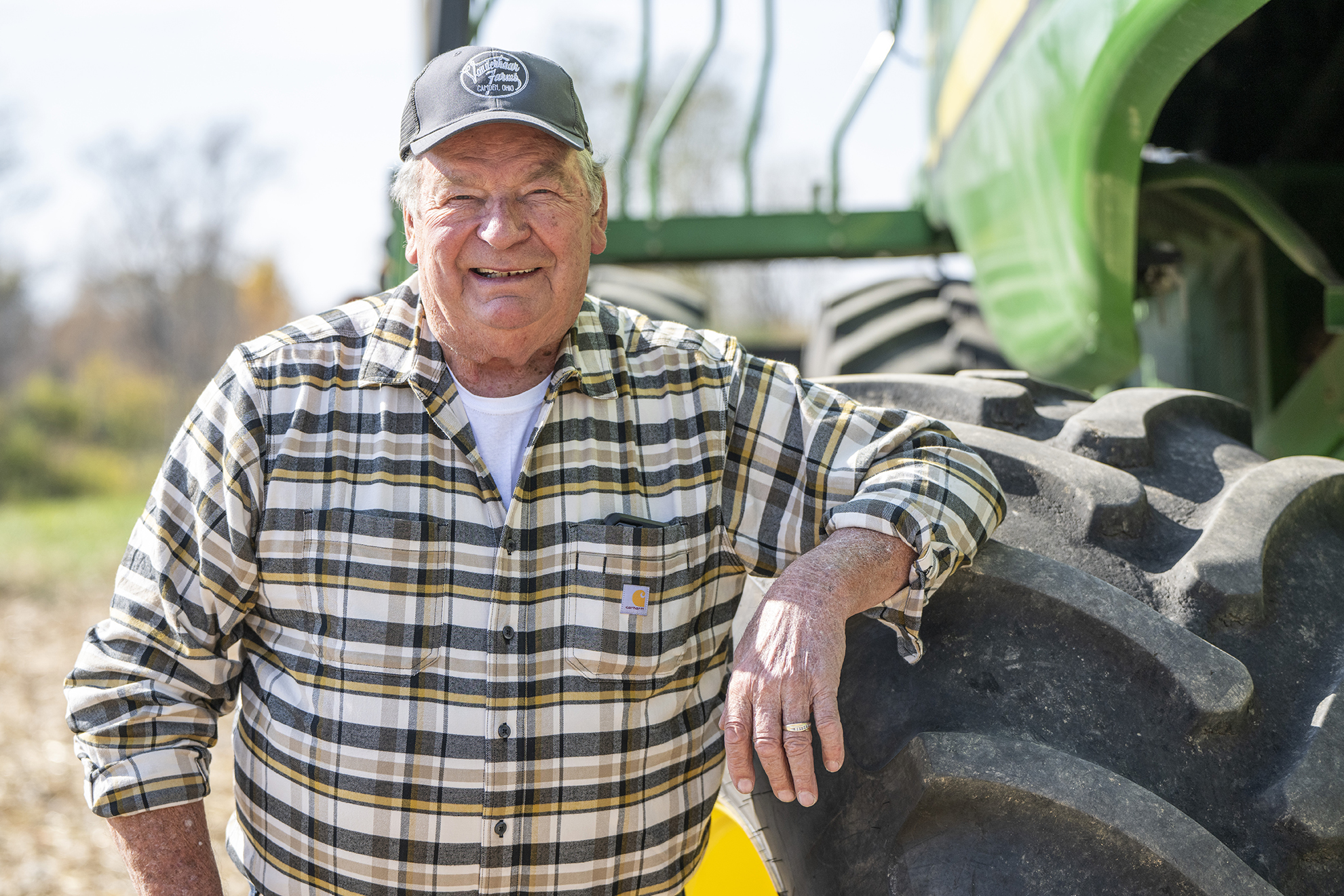A drum beat brings renewed joy
Drumming for Wellness unites Ohio State students and people with Parkinson’s
Ruthie Clemons is surrounded by new friends and her supportive family, tapping away on a black drum as she fights Parkinson’s disease within a church in Lima.
“I do the best I can,” said Clemons, 80 years old. “I can’t bang them like they do. I can’t get the beat at all sometimes. But it’s a blessing because it takes my mind off my problems.”
Each Monday this spring, Clemons participated in the Drumming for Wellness class conducted by Ohio State Lima in partnership with a Parkinson’s wellness group from Lima’s Mercy Health-St. Rita's Medical Center. Designed and instructed by lecturer Austin Thomas ’23 MA, each class unites Ohio State students and the Parkinson’s group to perform drum beats and exercises created specifically to fight the symptoms of the neurological disorder.
“We’re not curing Parkinson’s, we’re not relieving them of their symptoms for the rest of their lives,” said Thomas, associated faculty member in the Department of Music. “But if they don’t think of their obstacles or symptoms for one hour, or if I can delay their symptoms for six weeks, that’s a win in my book.”
There’s no cure for Parkinson’s disease, which progressively impairs movement as the brain cells that produce dopamine die off. The best anyone can do is keep the symptoms at bay, stave off the tremors, the stiffness, keeping limbs from freezing.
Exercise and a social life are key, and participants get both during Drumming for Wellness. Plus, music and drumming have been shown to benefit people with Parkinson’s in many ways, boosting flexibility, strength, coordination and cognitive functioning, potentially even increasing dopamine levels.
“Parkinson’s affects your mood, your cognition, your energy levels,” said Heather Harvey, the rehab technician who oversees the Parkinson’s wellness group. “But when you have a drum and you’re doing arm raises as you keep a beat, it’s more fun than other exercises we may do.
“There’s a lot of enthusiasm for Austin’s classes. They’re engaging with students and with each other. It’s not just that we’re physically moving, but we’re also exercising social interactions, our emotions. Not only do I see people moving better, I see them engaging, I see laughter, I see smiles.”
That last one? It’s a big one. Just ask Clemons.
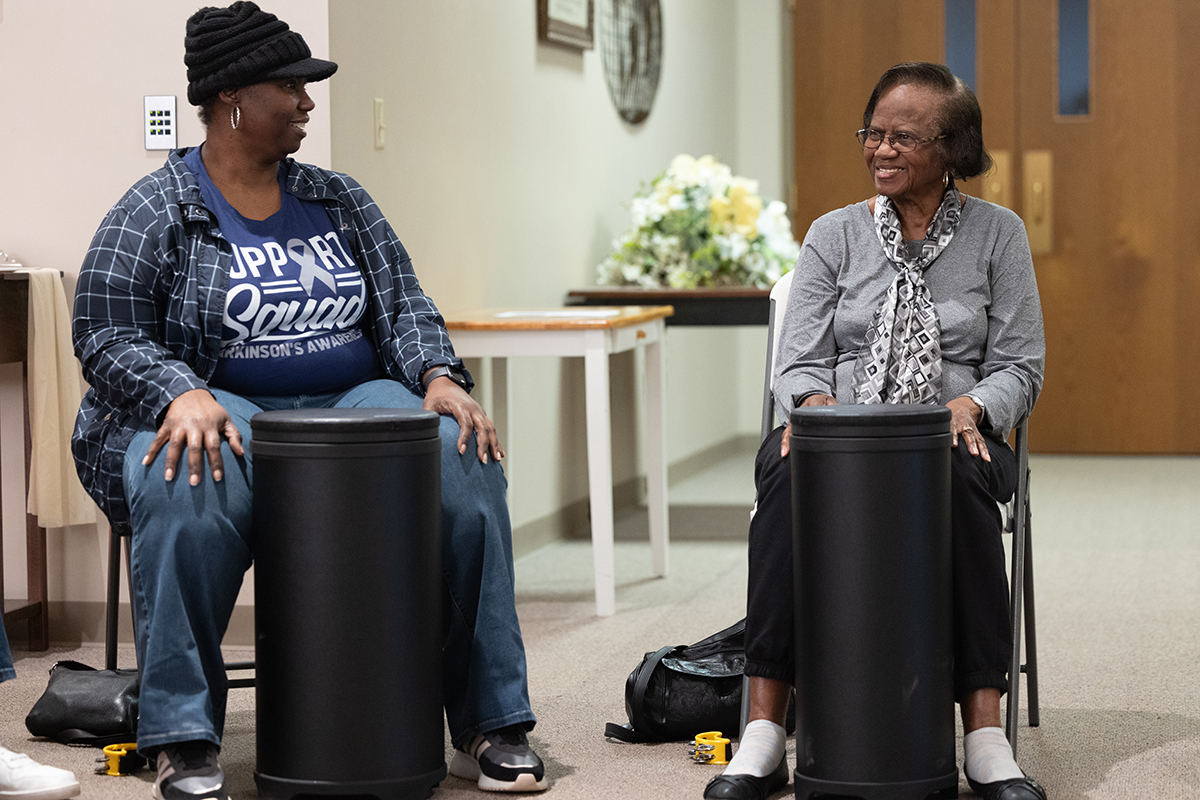
‘Lord, let me smile’
It’s called “masking,” a common symptom in people with Parkinson’s, in which facial expressions become reduced, blunted, blank.
Watching Clemons’ family in a Drumming for Wellness class — her daughter Yolanda and her sons Arron, Stevon and Marcus — there’s a familial theme: big smiles.
“We laugh a lot, we joke, we kid around a lot,” Yolanda said. “When mom couldn’t smile, that cut deep. That was the hardest part, that expressionless look.”
During dinners, family parties, Yolanda’s once vibrant, outgoing mom was physically there, but an emotional shell.
Diagnosed with Parkinson’s in 2018, Clemons withdrew as the symptoms took hold, stealing her sense of smell, her confidence in being able to walk without falling, to eat without dropping food, and it claimed her smile.
Before long, it was no more church. No more leaving the house. No more meals with family.
“My mom was superwoman,” Yolanda said. “Raised four kids, kept the house clean, worked a full-time job, just extremely active. To see the change, it was hard.”
Clemons joined Harvey’s Parkinson’s wellness group about four years ago after Yolanda found it and Arron showed up each week to take her. The group meets from March through November, with the Drumming for Wellness class taking up six weeks of that.
When she first attended one of Harvey’s exercise classes, she hid in the restroom. Little by little each week, she began participating. At one of them, Harvey asked the class to smile.
“The first time they put a drum in front of me, I thought, what am I supposed to do with this? Then we started and it was boom, boom, boom. I found myself working my legs, my arms, looking around at everybody. I was happy. It changed the way I was feeling.”
“Everyone was smiling but I couldn’t,” Clemons said. “I’d think, ‘Lord, let me smile.’ I was happy inside, but I couldn’t show it. I’d be dying to smile.”
Harvey’s exercises and the group itself helped Clemons physically and emotionally regain much of what was lost. Since joining, she’s done everything from flying for the first time to rejoining her social circles. Yolanda calls her the “selfie queen” now that she’s back to doing her own hair again.
It even got her to try new things, like drumming.
“The first time they put a drum in front of me, I thought, what am I supposed to do with this?” Clemons said. “Then we started and it was boom, boom, boom. I found myself working my legs, my arms, looking around at everybody. I was happy. It changed the way I was feeling.”
As she says this, you notice Clemons tapping her feet to the ground, her hands to her lap. Since the Drumming for Wellness classes, she turns on her favorite spiritual music to relieve anxiety, tapping to the beat.
“I wish I had a drum in front of me right now,” she said during an interview. “I wouldn’t be so nervous.”
Hearing that, Thomas smiles. “It’s really touching,” he said. “It just shows how much this program means to people.”
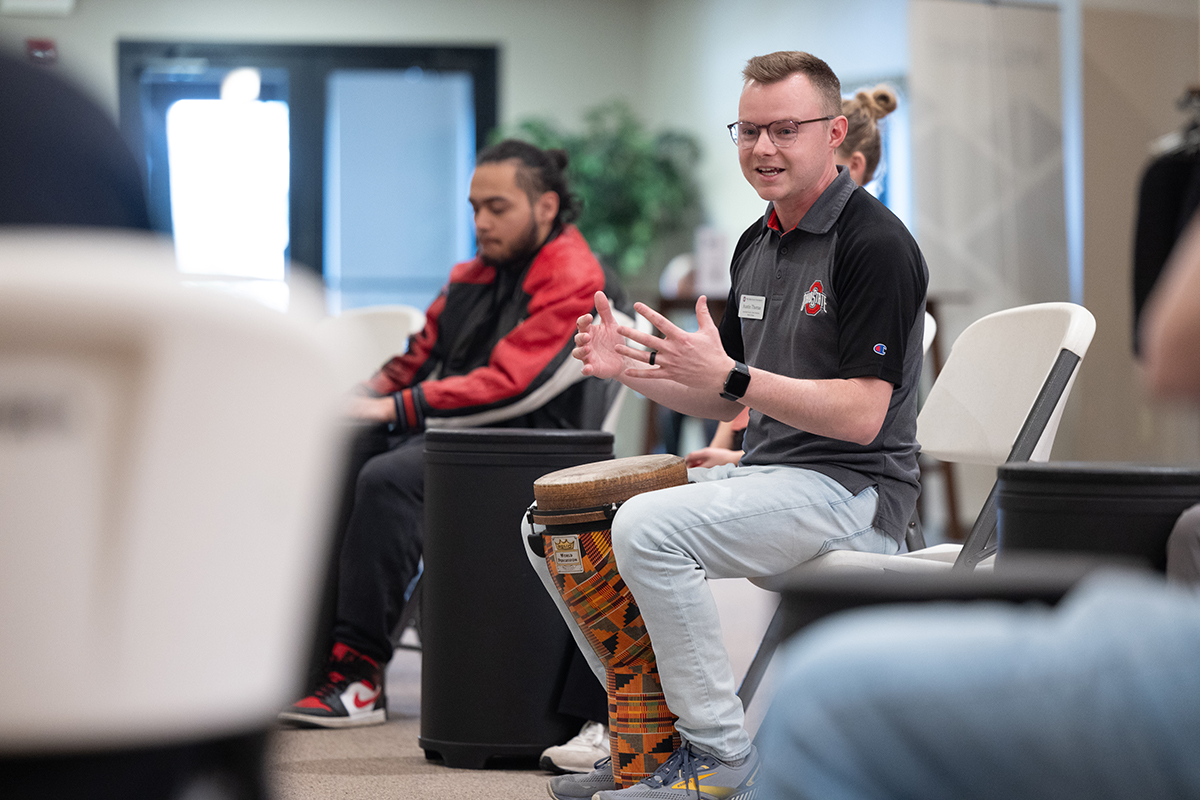
Opening eyes
Leading the drumming circle, Thomas pounds out a rhythm before teaching it to the class.
Next, he asks participants to name their favorite fruit. With each fruit, starting with “pear” and ending with “cherries,” the class is tasked with speaking the sequence of words and then drumming the original rhythm. It’s an exercise Thomas and his students designed to help with memory, multitasking, hand-eye coordination and focus.
With each class, Thomas designs similar exercises to combat other physical obstacles for people with Parkinson’s. Though he has a music background, Thomas has had to learn the music therapy piece on the fly. Likewise, none of the students came to Ohio State to study music.
An odd contrast, but it works.
“This program has been so rewarding,” Thomas says. “I never thought a music background would be put to this use but I’m so glad it is. It’s opened my eyes to how music can help a person change and overcome obstacles.”
Ohio State Lima’s dean and director Margaret Young got the class off the ground originally, adapting it from a graduate course developed by Ohio State’s Eugenia Costa-Giomi. Then a music faculty member, Young envisioned it as a service-learning opportunity and brought it to fruition with Heather’s partnership.
“Drumming for Wellness allows our students to engage directly with our community for its benefit, and that’s ultimately what we were designed to do as a land-grant institution,” she said. “To see the impact it is having on our students, hearing feedback about what they’ve gained through this class, it’s what fuels us as educators.”
The student majors in the class range from animal sciences and engineering to education and social work. Thomas admits that at the start of the class, which includes six weeks of learning about engaging with the Parkinson’s community before the workshops start, many students simply want a credit. They wind up gaining much more.
“When she first started, my brother sent me a video of her drumming and I thought, ‘not my mom.’ I was shocked it was from Ohio State. It is a small thing with a big impact for the participants and the families.”
“This is a class I’ll take with me wherever I go,” said Emily Rode, a social work major who is considering the medical field. “It’s a big learning experience for everybody. We talk a lot about rolling with the punches, and you learn that directly from working with this group.
“It’s interesting how different Parkinson’s looks for every single person. For some of them, it’s a big step to even show up. They’re all very confident and brave.”
The participants benefit from interactions with the students as well, according to Charles Cheuvront ’73, whose wife Carole is a Parkinson’s participant. He also says the class doesn’t just benefit those with Parkinson’s.
“It benefits the spouses, the kids, the families,” Cheuvront said. “It gives us more time with them to interact in different ways, it’s another avenue for socialization, it’s a community, that’s the benefit.”
Carole has done Drumming for Wellness twice now and has improved both times, says Charles, a former music teacher. He’s also noticed physical benefits for Carole, such as watching her signature improve.
“It takes out some of my frustration to beat on something,” Carole said. “I enjoy feeling I’m not alone. I have people who are in the same rocky boat I’m in.
“People younger and older than I am in this group, we all have a common theme, trying new things. Seeing what we can do. It’s nice having those conversations. When we don’t get together, I can feel the anxiety build quickly and it’s because I don’t have that camaraderie.”
Yolanda calls the exercise class Ruthie’s crew. And without it, she doesn’t think her mom would have ever tried drumming — more proof of how far she’s come.
“When she first started, my brother sent me a video of her drumming and I thought, ‘not my mom,’” Yolanda said. “I was shocked it was from Ohio State. It is a small thing with a big impact for the participants and the families. To see a family member participate and do things they’ve never done before is an incredible value.”
It’s a value Clemons wears on her face every class.
“I can’t smile like I used to but it’s coming back,” she said. “I prayed many prayers to get here, and I’ve come a long way. I’ve come so far it scares me.”
